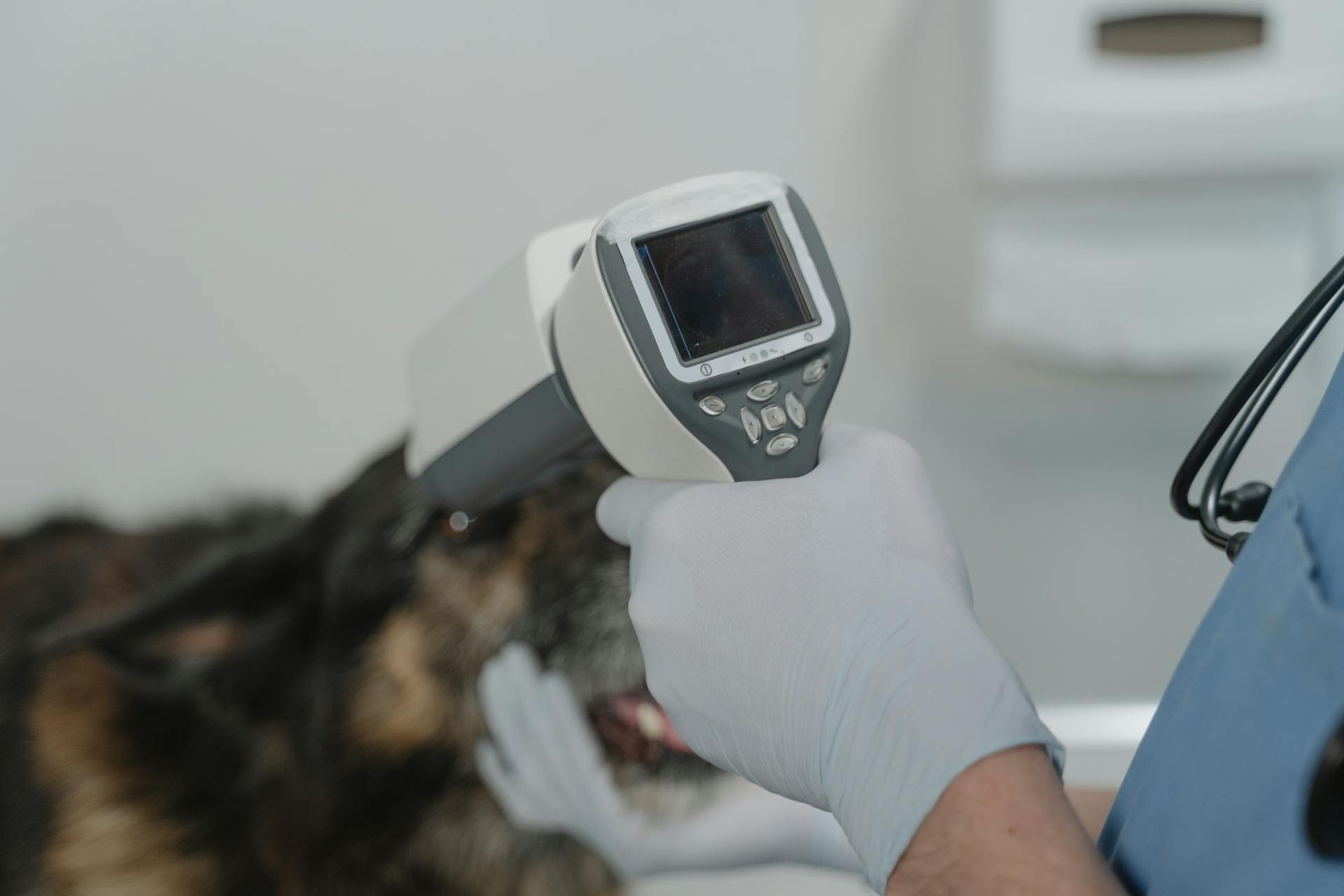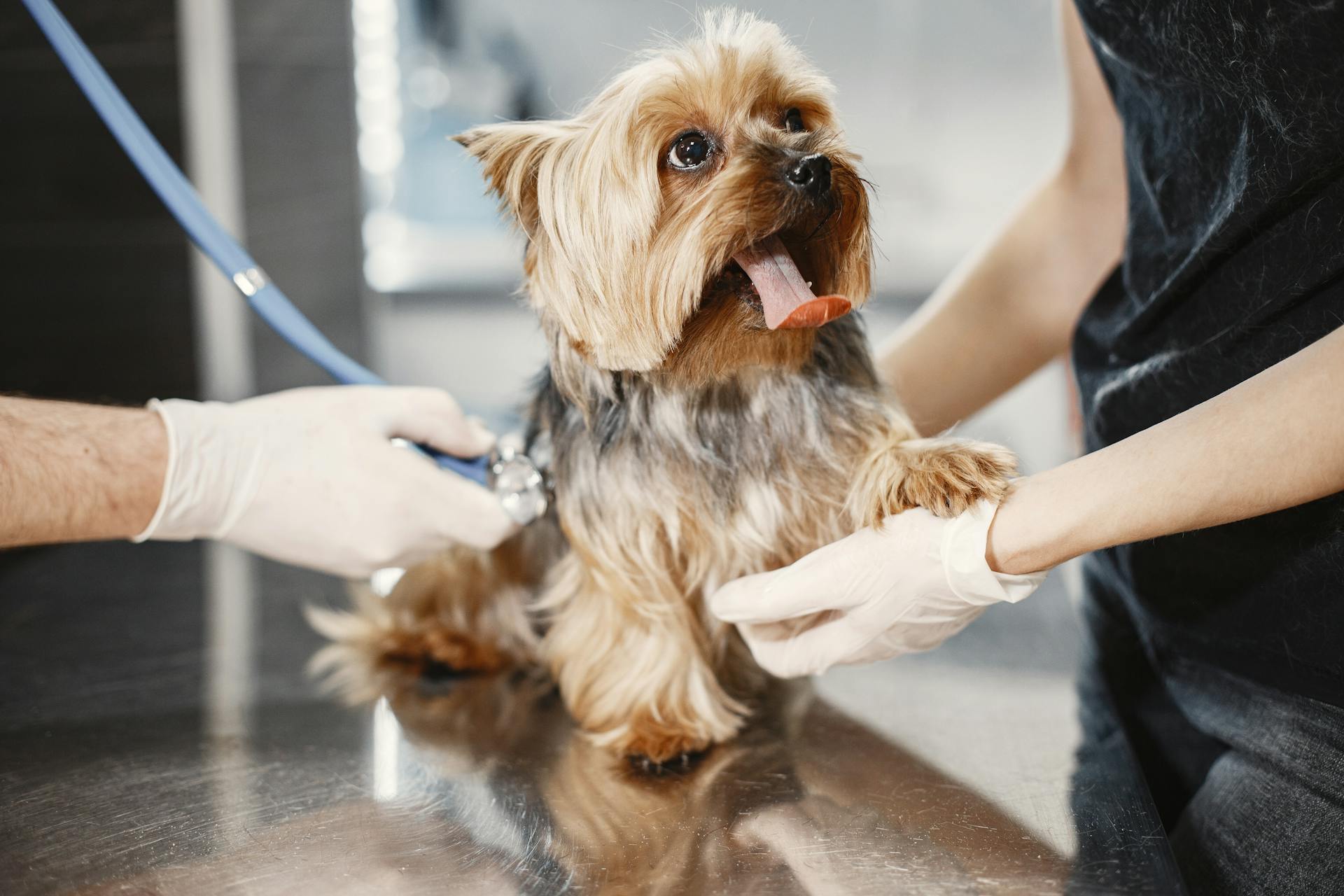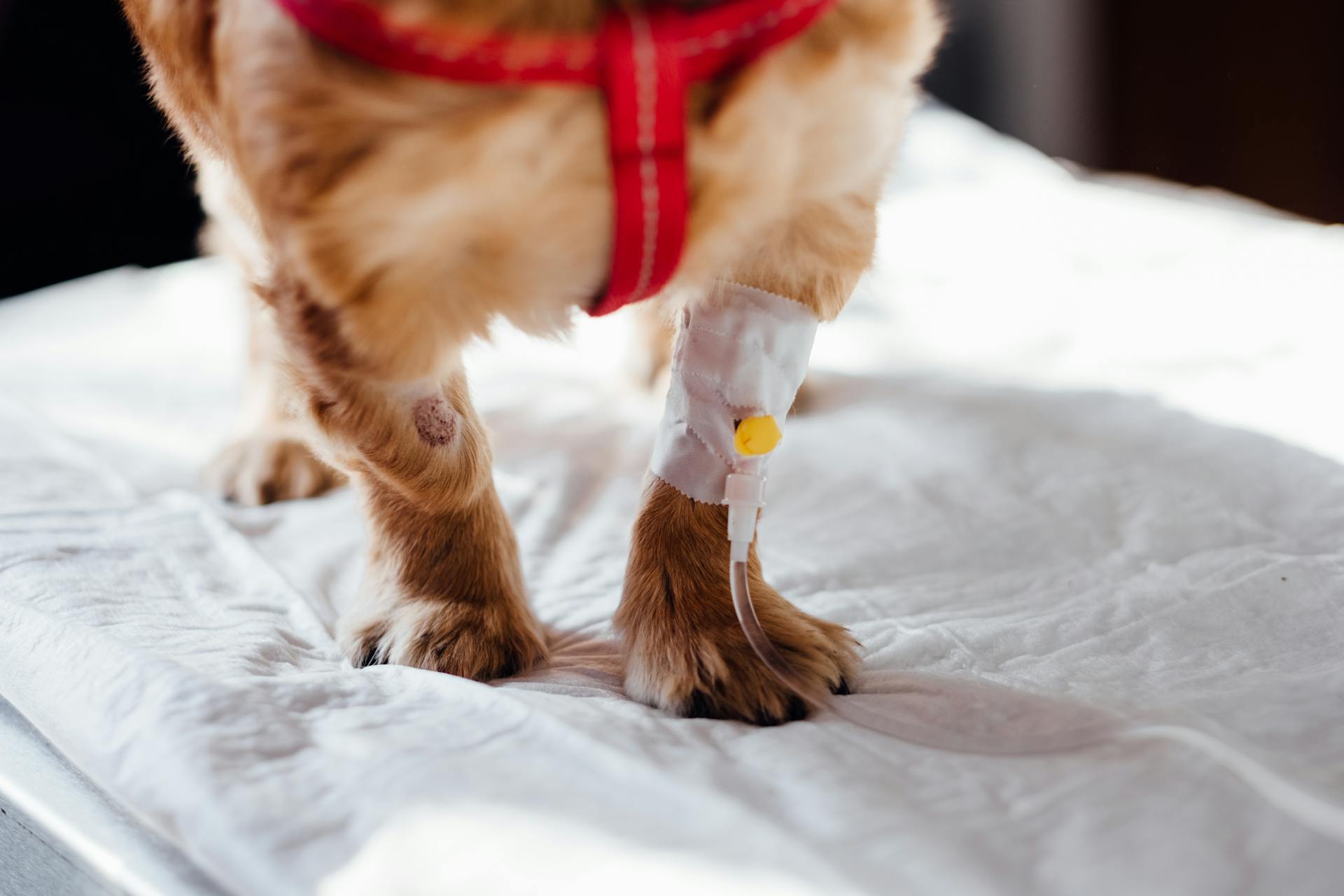
Prednisone is a corticosteroid medication commonly used in canine cancer treatment. It's often prescribed to help manage symptoms and alleviate pain.
Prednisone works by suppressing the immune system, which can help reduce inflammation and swelling. This can be particularly beneficial for dogs with cancer-related inflammation.
As a medication, prednisone is available in various forms, including tablets, liquid, and injectable solutions. Your veterinarian will determine the best form for your dog.
The dosage of prednisone will depend on the type and severity of your dog's cancer, as well as their overall health.
What is Prednisone for Canine Cancer?
Prednisone is sometimes used as antineoplastic treatment for some neoplasia, or cancer, in dogs. This means it can help slow down or control the growth of certain types of cancer.
As a medication, prednisone has a broad range of uses, including treating conditions like allergic reactions, arthritis, and inflammatory bowel disease. These conditions can sometimes be linked to cancer, either as a cause or a result.
Prednisone can be used to treat autoimmune diseases, including lupus and autoimmune hemolytic anemia, which can also be associated with cancer. It's essential to work closely with a veterinarian to determine if prednisone is the right treatment for your dog's specific cancer diagnosis.
Some common uses of prednisone in dogs include replacement therapy for endocrine disorders, such as Addison's disease. This condition can be related to certain types of cancer, making prednisone a useful treatment option.
Here are some of the conditions that prednisone can help with in dogs:
- Allergic reactions
- Asthma
- Hives and itching
- Skin diseases
- Arthritis
- High calcium levels
- Orthopedic diseases
- Nervous system disorders
- Inflammatory bowel disease (IBD)
- Autoimmune diseases, including lupus and autoimmune hemolytic anemia (AIHA)
How Prednisone Works
Prednisone mimics the body's cortisol structure, allowing it to easily enter cells and bind to glucocorticoid receptors throughout the body. This is why prednisone can be effective for a wide range of medical conditions, including canine cancer.
Prednisone's ability to reduce inflammation and affect the immune system is due to its inhibition of white blood cell functions, including growth, development, movement, and response to inflammation triggers. This inhibition is around four times stronger than natural cortisol, making prednisone a potent anti-inflammatory.
The anti-inflammatory action of prednisone can have significant side effects, such as increased urination and thirst, and gastrointestinal bleeding and ulcers, especially in high doses. Your veterinarian will want you to monitor these side effects and adjust the dose or use extra support to manage them.
Here are some key effects of prednisone on the body:
- Reduces inflammation and swelling
- Suppresses the immune system
- Increases urination and thirst
- Reduces the production of mucus in the stomach
How It Works
Prednisone is a steroid that mimics the body's cortisol structure, allowing it to easily enter cells and exert its effects.
By binding to glucocorticoid receptors in different cell types throughout the body, prednisone can have a wide range of effects, including reducing inflammation and suppressing the immune system.
The anti-inflammatory action of prednisone is around four times stronger than natural cortisol, which is why it's often used to treat a variety of medical conditions.
However, this strong action also comes with a risk of side effects, which can develop quickly, especially when used in high doses.
Some common side effects of prednisone include increased urination and thirst, as well as gastrointestinal bleeding and ulcers.
Here are some of the ways prednisone can affect the body:
- Reduces the release of anti-diuretic hormone from the kidneys
- Reduces the production of mucus in the stomach
- Inhibits the growth, development, movement, and response of white blood cells
These effects can be managed with careful dosing and monitoring, but it's essential to work closely with a veterinarian to ensure the best possible outcome for your dog.
Helping with Pred
Prednisone stimulates increased urination, so your dog needs to drink more water to avoid dehydration. This is especially important, as dogs on prednisone may not always recognize when they need to go to the bathroom.
Offer your pup as much water as they need, and take them outside to use the bathroom more often. This will help prevent urinary tract infections from developing.
Even well-trained dogs can have urinary accidents in the home because of the need to go more often, so be patient with your pup if that happens.
Giving prednisone with a bit of food can help decrease the chances of an upset tummy. Avoid giving it on an empty stomach.
If your dog on pred is nauseous, there are resources available to help you recognize and treat the symptoms.
Using Prednisone for Canine Cancer
Using prednisone for canine cancer can be a game-changer for many dogs, but it's essential to understand its limitations and potential side effects.
Prednisone is a synthetic glucocorticoid that mimics the action of cortisol in the body, and it can help reduce inflammation and slow down cancer progression when used with other chemotherapeutic agents. It's not a cure-all, but it can improve the quality of life for dogs with cancer.
The dosage of prednisone for dogs can vary widely depending on the health problem being treated, and veterinarians will often start with a high dose for a few days before gradually decreasing it over a few weeks. It's essential to follow a veterinarian's prescribed dosage very strictly and to taper off the medication gradually to avoid withdrawal symptoms.
Here are some key things to keep in mind when using prednisone for canine cancer:
- Always follow a veterinarian's prescribed dosage and tapering schedule.
- Monitor your dog's bloodwork, urinalysis, and other health indicators regularly.
- Be aware of potential side effects, such as increased urination and appetite changes.
- Don't give your dog human medications, as they can be toxic to dogs.
By understanding the benefits and limitations of prednisone, you can make informed decisions about your dog's care and work with your veterinarian to develop a treatment plan that's tailored to their needs.
Cancers
Prednisone can be used to help reduce inflammation and slow down cancer progression in dogs, especially when used in combination with other chemotherapeutic agents.
It's essential to note that prednisone is not a cure for cancer, but it can improve the quality of life for dogs with cancer by reducing symptoms such as nausea and vomiting.
Veterinarians often use prednisone to treat various types of cancer in dogs, including skin conditions, and it can be administered orally or topically.
The right dosage of prednisone for dogs depends on their weight and medical condition, and it's crucial to follow a veterinarian's prescribed dosage strictly.
Here are some common monitoring practices with prednisone:
- Bloodwork and urinalysis
- ACTH stimulation tests
- Blood sugar levels
- Signs of swelling
- Appetite and weight changes
- Potential adverse reactions
In some cases, prednisone can be used to reduce swelling associated with neurologic tumors, which can lead to improved symptoms, but the improvement is not permanent.
The effects of prednisone can last longer in dogs with kidney and liver disease, but it's essential to follow the instructions carefully and not stop the medication abruptly.
The Right Dosage
The right dosage of prednisone for your dog is crucial in treating canine cancer. Your veterinarian will prescribe a specific dosage based on your dog's unique weight and medical condition.
To ensure you get the dosage right, follow your vet's instructions closely and only give what is recommended. This is especially important as too little prednisone may not have any effect, while too much can cause severe problems like organ damage or even death.
The typical dosage of prednisone for dogs is 2.5 mg per 10 lbs, but this can vary depending on the condition being treated and your dog's overall health. For example, dogs weighing 5 to 20 lbs may require 1.25 to 5 mg per day, while those weighing 40 to 80 lbs may require 10 to 20 mg per day.
Here are some general guidelines for prednisone dosages based on your dog's weight:
Remember, every dog is unique, and your veterinarian will tailor the dosage to your dog's specific needs. Be sure to follow their instructions closely and only give the recommended dosage to ensure the best possible outcome.
Inflamed Masses
Inflamed masses can be a challenging issue for dogs with cancer. Prednisone may be included in the treatment for masses that are large or fast growing, or where inflammation creates pain or complications.
As cancer creates inflammation in and around the tumor, reducing it often makes your dog more comfortable. This is especially true for masses that are causing pain or discomfort.
Surgical removal is often the treatment of choice for inflamed masses, but prednisone can be used to reduce swelling and inflammation before surgery. By reducing the size of the tumor, prednisone can make surgical removal more effective.
Here are some benefits of using prednisone to treat inflamed masses:
- Prednisone can reduce swelling and inflammation around the tumor, making your dog more comfortable.
- Prednisone can make surgical removal more effective by reducing the size of the tumor.
- Prednisone is a relatively inexpensive and easy-to-administer medication.
It's essential to note that prednisone is not a substitute for surgery, but rather a complementary treatment to help manage symptoms and improve quality of life.
Hide Treat with Predator
Hiding prednisone in a treat is a great way to make giving medicine to your dog easier and less stressful for both of you. Giving prednisone with food decreases the risk of an upset tummy from the medication.
Try hiding the pill in a type of food your dog loves, something that's a special treat. Foods that work well for this are sticky peanut butter or Cheez Whiz, a piece of hot dog, or a meatball made from their favorite canned food.
Only give your dog the amount of treat needed to take the medicine, as too many treats can cause a stomachache or lead to weight gain or other health problems. Keep in mind your dog's tolerance for these foods.
Liquid formulations are also an option if your dog doesn't do well with pills.
Potential Benefits and Risks
Prednisone can provide multiple benefits to dogs with lymphoma, including shrinking tumors directly, reducing lymph node swelling, reducing generalized inflammation, and improving quality of life.
It can be used as part of a multi-drug protocol, such as the UW CHOP protocol, which can extend a dog's life by an average of 13-14 months.
Readers also liked: Canine Bone Cancer Life Expectancy
However, prednisone can also have risks, especially with long-term use, including stomach ulcers, weight gain, muscle loss, delayed wound healing, hair loss or skin problems, yeast or bacterial infections, liver problems, diabetes mellitus, and decreased production of thyroid hormone.
Additionally, prednisone can interfere with the effect of other chemotherapy agents and contribute to multi-drug resistance (MDR), making it less effective when used in combination with other treatments.
You might like: Canine Vision Loss
What Are the
What Are the Potential Benefits and Risks?
The potential benefits of this technology are numerous, with some studies showing a 25% increase in productivity among users.
Improved collaboration and communication are also key benefits, allowing teams to work together more efficiently and effectively.
Reducing errors and improving data accuracy are also potential benefits, with some companies reporting a 30% reduction in errors.
Increased flexibility and autonomy are also on the table, with some users reporting a 40% increase in job satisfaction.

However, there are also potential risks to consider, such as job displacement and cybersecurity threats.
The risk of job displacement is a significant one, with some estimates suggesting that up to 30% of jobs could be automated in the next decade.
Cybersecurity threats are also a major concern, with some companies reporting a 50% increase in cyberattacks in the past year.
Risks
Prednisone and prednisolone should not be given to dogs with allergies to the drug. This is a serious concern that requires careful consideration.
Dogs with systemic viral infections, fungal infections (with the exception of Addison's disease), Cushing's disease, tuberculosis, or ulcers should also avoid these medications. It's essential to weigh the benefits against the risks in these cases.
Prednisone and prednisolone should be used with caution in dogs with heart disease, diabetes, cataracts, osteoporosis, kidney disease, increased blood pressure, and other types of infections. Puppies are also at risk, as these medications can inhibit growth.
Explore further: Canine Lupus

Animals receiving prednisone or prednisolone might be more susceptible to viral and bacterial infections. These drugs can also mask signs of infection, like elevated temperature.
Here are some serious side effects that can occur with long-term use of prednisone:
- Stomach ulcers.
- Weight gain.
- Muscle loss.
- Delayed wound healing.
- Hair loss or skin problems.
- Yeast or bacterial infections (especially at high doses).
- Liver problems.
- Diabetes mellitus.
- Decreased production of thyroid hormone.
Using prednisone with non-steroidal anti-inflammatory drugs (NSAIDs) increases the risk of stomach ulcers significantly. This is a crucial consideration when treating your dog's pain or inflammation.
Due to prednisone's effects on the immune system, certain supplements can be harmful or alter its effects. These include medicinal fungi, echinacea, astragalus, ginseng, thunder god vine, and licorice root. Always consult with your veterinarian before giving your dog any supplements.
Suggestion: Canine Cancer Supplements
Non-Steroidal Anti-Inflammatory Drugs
Using prednisone or prednisolone with non-steroidal anti-inflammatory drugs (NSAIDs) can increase the risk of stomach ulcers significantly. This is a serious concern that pet owners should be aware of.
Some common NSAIDs that can interact with prednisone or prednisolone include aspirin, Carprofen, Etogesic, Deramaxx, Metacam, Novocox, and Previcox. These medications should be used with caution, and your vet should be informed if your dog is taking any of these.
The risk of stomach ulcers is a major concern when using NSAIDs with prednisone or prednisolone. In fact, if your dog is on a large dosage of prednisone, vaccination may be less effective or even result in infection.
Here's a list of some common NSAIDs to watch out for:
- Aspirin
- Carprofen
- Etogesic
- Deramaxx
- Metacam
- Novocox
- Previcox
Your vet should be informed of any medications, supplements, or vitamins your dog is taking, including NSAIDs. This will help prevent potential interactions and ensure your dog's safety.
Immune Supplements
If you're considering adding immune supplements to your dog's regimen while taking prednisone, it's essential to exercise caution. Some supplements can interact with prednisone and alter its effects.
Medicinal fungi, echinacea, astragalus, ginseng, thunder god vine, and licorice root are examples of immune supplements that may be harmful or alter prednisone's effects. These supplements should be used only after consulting with your veterinarian.
Your vet might recommend using half or a quarter of the usual dose of these supplements to reduce the risk of an upset stomach.
Lowering Excessive Blood Calcium
Certain cancers, such as lymphoma and anal sac tumors, can cause high levels of calcium in a dog's blood.
Prednisone is one of the medications used to mitigate this problem.
If left untreated, excessively high calcium levels can be life-threatening.
Lymphoma
Lymphoma is a type of cancer that affects lymphocytes, blood cells that are part of your dog's immune system. Lymphoma can't be removed surgically because the cancer cells circulate throughout the body via the blood.
Prednisone can be used to treat lymphoma, but its effectiveness depends on the treatment protocol. As part of the UW CHOP protocol, a common chemotherapy protocol, prednisone is one of four drugs given and can extend a dog's life by an average of 13-14 months.
Prednisone can also be used as a solo treatment, but this only extends a dog's life for an average of 2-3 months. However, during this time, the medication can make an ill dog with lymphoma feel much better, so they really enjoy the time they have left.
Explore further: Canine Epitheliotropic Lymphoma

The life expectancy for dogs with lymphoma treated with prednisone alone is 1-2 months, which may not be significantly longer than the life expectancy without treatment. However, prednisone quickly helps relieve the symptoms of lymphoma, making dogs feel very sick.
Here are the most common ways prednisone is used to treat lymphoma:
- As part of the UW CHOP protocol, a common chemotherapy protocol used for lymphoma.
- As a solo treatment, which only extends a dog's life for an average of 2-3 months.
It's essential to discuss your dog's treatment plan with your veterinarian before starting prednisone, especially if you want to use multi-drug chemo protocols. Starting prednisone too soon can make other lymphoma treatments less effective.
Frequently Asked Questions
How does prednisone help mast cell tumors in dogs?
Prednisone helps mast cell tumors in dogs by directly killing cancerous mast cells and reducing inflammation and the effects of degranulation associated with the tumor. This can help alleviate symptoms and potentially slow tumor growth.
Sources
- https://www.dogcancerblog.com/articles/choosing-treatments/prednisone-for-dog-cancer-2/
- https://www.pawlicy.com/blog/prednisone-for-dogs/
- https://carecard.com/blog/what-you-need-to-know-about-prednisone-for-dogs
- https://www.dogcancer.com/articles/drugs/prednisone-for-dogs/
- https://www.dogcancerblog.com/articles/full-spectrum-cancer-care/conventional/prednisone-for-dogs/
Featured Images: pexels.com


